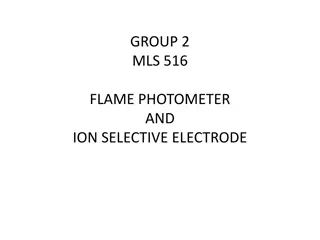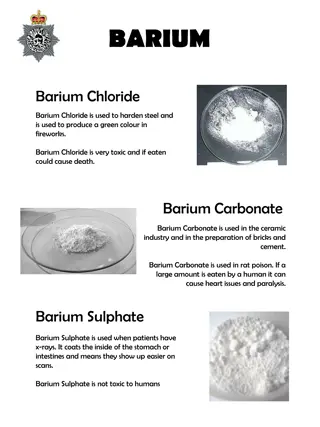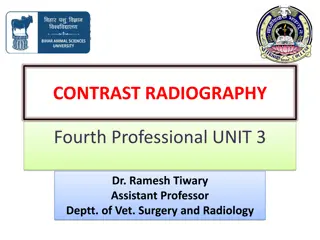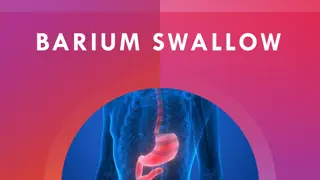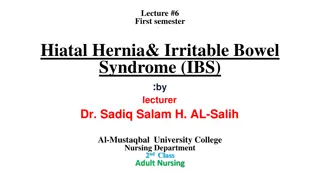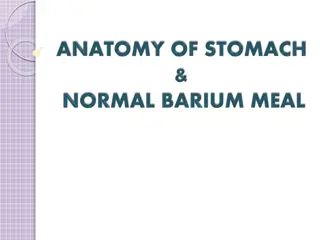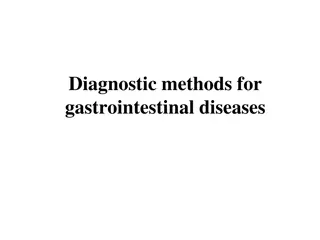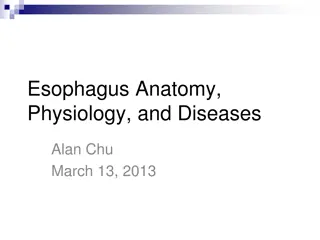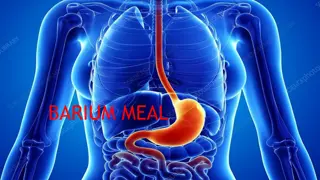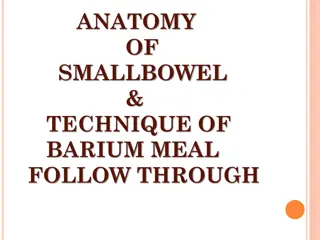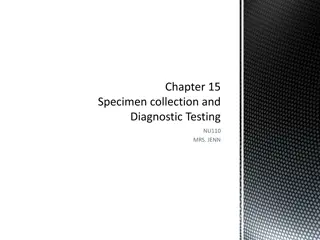Understanding Flame Photometry and Its Applications
A photoelectric flame photometer is utilized in inorganic chemical analysis to determine metal ion concentrations such as sodium, potassium, lithium, barium, and calcium. The photometer measures light intensity emitted when elements are exposed to a flame. By controlling flame color intensity, the d
0 views • 25 slides
Chemical Compounds Overview: Barium, Calcium, Sodium, Lithium
Learn about the uses and potential dangers of Barium Chloride, Barium Carbonate, Barium Sulphate, Calcium Chloride, Calcium Carbonate, Calcium Sulphate, Sodium Chloride, Sodium Carbonate, Sodium Sulphate, Lithium Chloride, Lithium Carbonate, and Lithium Sulphate in various industries and application
0 views • 4 slides
Neonatal Vomiting: Causes, Diagnosis, and Differential Diagnosis
Neonatal vomiting can be a concern when presenting with bile-stained or blood-stained vomit, projectile vomiting, or associated with weight loss and failure to grow. Various non-surgical and surgical conditions like Pyloric Stenosis can lead to vomiting in neonates. Common causes include Mid-gut vol
0 views • 16 slides
Understanding Contrast Radiography in Veterinary Surgery and Radiology
Contrast radiography is a crucial technique in veterinary medicine that involves using contrast media to enhance visualization of organs and lesions. Different types of contrast media, positive and negative, are used to alter tissue radio density for better demarcation. Barium and iodine compounds a
0 views • 14 slides
Comprehensive Guide to Barium Swallow Procedure
Barium swallow is a dedicated test to evaluate the pharynx, esophagus, and proximal stomach. It helps diagnose conditions like dysphagia, obstructions, and motility disorders. This guide covers the indications, contraindications, preparation, contrast agents used, and evaluation steps for the proced
0 views • 13 slides
Significance of Pear-Shaped Nuclei in Atomic Physics
Causes of deformation in atomic nuclei, leading to pear-shaped structures, are explored with examples such as 224Ra and 220Ra. Measurement of Barium isotopes using advanced techniques sheds light on the spatial asymmetry of nuclei. The significance of pear-shaped nuclei in explaining CP-symmetry bre
0 views • 7 slides
Understanding Hiatal Hernia and Irritable Bowel Syndrome (IBS) for Adult Nursing
A hiatal hernia involves the protrusion of the stomach through the diaphragm, leading to various types and complications. Symptoms may include heartburn and dysphagia, diagnosed through barium studies and endoscopic exams. Management includes lifestyle changes, medication, and surgical repair. Nursi
0 views • 15 slides
Comprehensive Guide to Stomach Anatomy, Histology, and Barium Meal Radiology
Learn about the intricate anatomy of the stomach, its histological structure, lymphatic drainage, and the use of barium meal radiology for diagnostic purposes. Discover indications and contraindications, patient preparation, and clinical scenarios where these procedures are essential.
0 views • 29 slides
Exploring the Fascinating World of Chemical Elements Through Visuals
Dive into the captivating realm of chemical elements with this visual presentation, showcasing images and descriptions of elements like Antimony, Platinum, Silver, Radon, Strontium, Xenon, Tin, Mercury, Iodine, Tungsten, Tantalum, Barium, Gold, Lead, and Cesium. Each element is depicted in a unique
0 views • 16 slides
Diagnostic Methods for Gastrointestinal Diseases: A Comprehensive Overview
Explore various diagnostic methods for gastrointestinal diseases, including laboratory investigations, abdominal ultrasound features, and radiology techniques. Learn about the significance of different tests such as ESR, blood count, liver tests, and abdominal ultrasound in diagnosing conditions aff
0 views • 40 slides
Understanding Esophagus Anatomy, Physiology, and Diseases
Explore the anatomy and function of the esophagus, including its layers, innervation, and common disorders like dysphagia, motility disorders, strictures, and rings/webs. Learn about diagnostic methods such as barium swallow studies and endoscopy, as well as treatment options for conditions like ach
0 views • 18 slides
Understanding Barium Meal Radiological Study
Barium meal is a radiological study of the upper gastrointestinal tract, including the esophagus, stomach, duodenum, and proximal jejunum. It helps diagnose various conditions such as peptic ulcers, cancers, and gastrointestinal obstructions. The procedure involves oral administration of barium cont
0 views • 11 slides
Understanding Small Bowel Anatomy and Barium Meal Technique
Exploring the anatomy of the small bowel, including the duodenum, jejunum, and ileum, as well as the technique of a barium meal follow-through. The small bowel is a convoluted tube extending from the pylorus to the ileocecal valve, averaging 6-7 meters in length. The duodenum, characterized by its C
0 views • 34 slides
Understanding Nuclear Fission: Process, Examples, and Energy Generation
Nuclear fission involves the splitting of an atomic nucleus, with uranium-235 being a commonly used fissile material. When uranium-235 undergoes fission, it produces fission fragments, neutrons, gamma radiation, and kinetic energy. The fission process can be initiated by absorbing a slow-moving neut
0 views • 19 slides
Guidelines for Safe and Efficient Diagnostic Testing Procedures
This content provides detailed guidelines and procedures for specimen collection and diagnostic testing in healthcare settings, covering aspects such as patient assessment, specimen labeling, completing diagnostic requisition forms, and specific procedures like amniocentesis, arteriography, barium e
0 views • 21 slides
